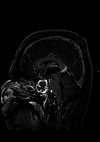Acromegaly Presenting with Resistant Acne Vulgaris
- PMID: 35813834
- PMCID: PMC9209982
- DOI: 10.1159/000525069
Acromegaly Presenting with Resistant Acne Vulgaris
Abstract
Acne vulgaris is one of the most frequent skin diseases worldwide, triggered by multiple endogenous and exogenous factors. Hormones, particularly growth hormone (GH), insulin-like growth factor-1, insulin, CRH, and glucocorticoids, play a major role in the pathogenesis and exacerbation of acne. Excess GH seen in acromegalic patients may result in increased size and function of sweat glands and sebaceous glands, which may contribute to the patient's worsening acne and interfere with dermatologic treatment. Therefore, understanding the pathogenesis of acne will help in treating resistant acne by diagnosing and treating the underlying etiology using multidisciplinary treatment.
Keywords: Acne vulgaris; Acromegaly; Resistant acne.
Copyright © 2022 by S. Karger AG, Basel.
Conflict of interest statement
Dr. Fatema Abdulwahab Khamdan, Milaan A. Shah, Dr. Maryam Ahmed Khamdan, and Dr. Eman Albasri have no conflicts to disclose.
Figures



Similar articles
-
Involvement of the corticotropin-releasing hormone system in the pathogenesis of acne vulgaris.Br J Dermatol. 2009 Feb;160(2):345-52. doi: 10.1111/j.1365-2133.2008.08959.x. Epub 2008 Dec 10. Br J Dermatol. 2009. PMID: 19077080
-
Acne and systemic disease.Med Clin North Am. 2009 Nov;93(6):1161-81. doi: 10.1016/j.mcna.2009.08.008. Med Clin North Am. 2009. PMID: 19932324 Review.
-
The role of neuropeptides in the multifactorial pathogenesis of acne vulgaris.Dermatoendocrinol. 2009 May;1(3):170-6. doi: 10.4161/derm.1.3.8496. Dermatoendocrinol. 2009. PMID: 20436885 Free PMC article.
-
Acne and sebaceous gland function.Clin Dermatol. 2004 Sep-Oct;22(5):360-6. doi: 10.1016/j.clindermatol.2004.03.004. Clin Dermatol. 2004. PMID: 15556719 Review.
-
Hormone therapy in acne.Indian J Dermatol Venereol Leprol. 2013 May-Jun;79(3):322-37. doi: 10.4103/0378-6323.110765. Indian J Dermatol Venereol Leprol. 2013. PMID: 23619437 Review.
Cited by
-
Effects of natural products on skin inflammation caused by abnormal hormones secreted by the adrenal gland.Front Pharmacol. 2023 May 3;14:1156271. doi: 10.3389/fphar.2023.1156271. eCollection 2023. Front Pharmacol. 2023. PMID: 37205913 Free PMC article. Review.
-
Acromegaly presented with acne vulgaris: a retrospective study with 123 cases.J Endocrinol Invest. 2024 Jun;47(6):1467-1476. doi: 10.1007/s40618-023-02254-6. Epub 2023 Dec 19. J Endocrinol Invest. 2024. PMID: 38112910
-
Skin assessment in congenital untreated isolated GH deficiency.Endocrine. 2024 Jun;84(3):1116-1124. doi: 10.1007/s12020-024-03840-1. Epub 2024 May 4. Endocrine. 2024. PMID: 38703329
References
-
- Toyoda M, Morohashi M. Pathogenesis of acne. Med Electron Microsc. 2001 Mar;34((1)):29–40. - PubMed
-
- Leonhardt JM, Heymann WR. Cutaneous manifestations of other endocrine diseases. In: Freedberg IM, Eisen AZ, Wolff K, Austen KF, Goldsmith LA, Katz SI, editors. Fitzpatrick's dermatology in general medicine. 6th ed. New York: McGraw-Hill; 2003. p. p. 1669.
-
- Kasper D, Fauci A, Hauser S, Longo D, Jameson J, Loscalzo J, editors. Harrison's principles of internal medicine. 19th ed. New York, NY: McGraw Hill; 2014.
-
- Holdaway IM, Rajasoorya RC, Gamble GD. Factors influencing mortality in acromegaly. J Clin Endocrinol Metab. 2004;89((2)):667–74. - PubMed
Publication types
LinkOut - more resources
Full Text Sources

